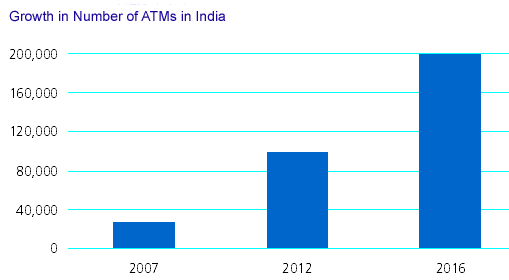The Indian ATM Industry
Gearing Up for the Next Phase of Growth
Abstract
The Indian ATM industry has witnessed rapid growth in the past decade. Economic development, growing income (especially in the urban areas), and a transition from class banking to mass banking were the main drivers. The industry is now entering the next phase; the main drivers for future growth are likely to be regulatory changes relating to financial inclusion, increasing penetration, and white-label ATMs.
In the report, The Indian ATM Industry: Gearing Up for the Next Phase of Growth, Celent studies the latest forces shaping the Indian ATM landscape and how the industry is meeting those challenges. The ATM industry has been a focus of recent discussion in India. Several forces are driving the heightened importance of ATMs. The biggest push has come from India’s central bank and banking regulator, the Reserve Bank of India (RBI).
A large proportion of India's population is still unbanked or underbanked. Banks have traditionally targeted urban areas for setting up new branches and ATMs, reaching a sizable population with relatively low investment in infrastructure. In spite of rapid ATM growth over the last decade, regions beyond India’s largest cities remain largely underserved. Recently, the Reserve Bank of India (RBI) has been trying to design policies to encourage financial institutions to look beyond the top cities.

Traditionally, banks owned their own ATMs. However, they are increasingly sharing ATM networks with other banks to increase reach. Outsourcing of ATMs is a recent phenomenon in India, since strict regulations have prohibited nonbanking companies from carrying out banking operations. However, this is likely to change with RBI’s approval of white-label ATMs in India.
“This change will have important implications for market players,” says Arin Ray, Analyst with Celent and author of the report. “Banks are slowly expected to move out of ATM operations and focus on their core business. Given that many of them have already built up a significant ATM base, they are unlikely to completely abandon their role in ATM management.”
Most of the new ATMs will be deployed in tier 2 and 3 cities, and a large proportion of them will be established following the “brown-label” outsourcing model in the next four years. The white-label ATM model has the potential to revolutionize the ATM landscape, and the implications for vendors are serious. Hardware vendors will see demand for their machines grow. Given that almost all of them are engaged in services and maintenance of ATMs, some may foray into the domain of white-label ATMs. Large local players that provide managed services and outsourcing services to banks are likely to move up the value chain and consider the white-label opportunity. Other firms associated with this industry, like telecom operators, network companies, and security and infrastructure providers will also see growth opportunity in the evolving scenario. Some large international players looking for growth opportunities may enter the Indian market with their established reputation and superior offering.
The first chapter in this report provides an overview of the Indian banking industry that is at the heart of ATM business. The next chapter delves directly into the ATM landscape and explains its evolution by studying its history, drivers of growth, challenges and barriers, and participants and their importance. The report also examines the main uses of ATMs in India, costs and expenses associated with this business, and some of the innovations that are taking place in the industry. A separate chapter is dedicated to analyzing the latest trends in servicing of ATMs. Finally, the report presents an overview of the vendor universe associated with this industry and some of the emerging trends.
This 30-page report contains 13 figures and 7 tables.

